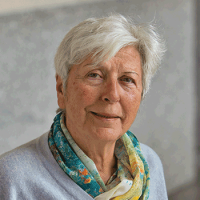Public Outrage: A Look at Protest Movements in Iran and the Arab World
Submit a question
Widespread protests have engulfed the streets of Iran following the death of Mahsa Amini, a 22-year-old from Iranian Kurdistan, for over a month. This is yet another wave of protests the Islamic Republic and its conservative political rule since the protests of 2009. At the same time, the Arab world has witnessed various waves of protest movements starting in 2010/2011.. The Middle East Program convened fellows Marina Ottaway, co-author of A Tale of Four Worlds: The Arab Region After the Uprisings, and Haleh Esfandiari, Middle East Program Director Emerita and Distinguished Fellow, to compare the protest movements in Iran and the Arab world, with a focus on the dynamics at play today.
Haleh Esfandiari explained the Iran protests unfolding today are different from past movements largely because historically protests quickly end after a few days due to brutal government crackdowns. Another distinguishable facor is he role of women “This time, the big difference was that the protest movement was led by women,” Esfandiari noted, adding, “It was the first time, in the history of the Islamic Republic, that women came out, protesting directly not only to what happened to Mahsa Amini,” but also against the corruption of the regime and economic hardships the Iranian people are facing.
Esfandiari reaffirmed the strength it requires among Iranian women to demonstrate and convince the men to join the movement. “I’m in awe of what the young women in Iran have achieved and are doing, and I’m happy to be around to have watched that the torch has passed, and it’s in very good hands.”
Parallels to the Arab World
Marina Ottaway argued one of the biggest barriers to successful protests during the 2010 – 11 Arab uprisings, and subsequent waves in 2018 and 2019, was the lack of leadership and organization. This reality meant most protests could not transform into a to revolution, and those that did failed. For example, while citizens in Algeria were able to sustain protests for a long period of time, they were unable to bring about true change. By contrast, the movement in Sudan saw more success due to professional networks – specifically, the law and engineering associations – who negotiated with the military and pushed for change. Unfortunately today, the military in Sudan is still consistently on the “verge of taking back what they conceded to civilians.” Ottaway stated, “That’s the real conundrum of all these movements. Organized movements are very easy for the governments to suppress…if there is a clear leader, you manage to arrest the leader.” As a result, protestors are hesitant to organize publicly, opting instead, “to have loose networks of organizations or organizers,” which are harder for the government to target and shut down. But when they don’t organize – there is no clear path to meaningful change.
In Iran, Esfandiari recalled, the revolution of 1979, “had a leader…sitting in Iraq. The country was inundated with tapes of Ayatollah Khomeini and also they had the network of mosques and clerics.” She argued, the combined efforts of the religious establishments and the “novelty of an Islamic Revolution” drew people into the movement. “The first two large marches arranged across the country was basically organized and run by the cleric with the help of political parties.”
Impact of the protests and help from the international community
According to both Ottaway and Esfandiari, Iran will only undergo transformation if the street movement is able to produce leadership and organization, or if a division in the government or amongst the political ruling elite emerges. Ottaway contended, “The most likely source of change will come from a split of leadership or from street movements triggering a split in the leadership.”
The international community has rallied around protestors in Iran, which begs the question how they can actually support people on the ground. Esfandiari suggested the United States ensure protestors have uninterrupted access to the internet, which is the “lifeline” of protestors. She also emphasized that all prisoners, particularly imprisoned children, should be freed. Although, Ottaway contended there is only so much the international community can do. “We, in the international community, delude ourselves into thinking that we can do something to really change the course of the uprisings…we can offer encouragement, we tell them we are with you…but there is very little we can do concretely.”
Ottaway explained it will be difficult to predict how the protests in Iran might affect other countries in the Middle East region. “The conditions exist in most Arab countries for flare-ups…there is no doubt.” However, it’s difficult to foresee when or where these developments may occur. “The triggers are unpredictable [and] the unfolding is unpredictable.”
Speakers

Former Senior Research Associate and Head of the Middle East Program, Carnegie Endowment for International Peace

Moderator

Hosted By

Middle East Program
The Wilson Center’s Middle East Program serves as a crucial resource for the policymaking community and beyond, providing analyses and research that helps inform US foreign policymaking, stimulates public debate, and expands knowledge about issues in the wider Middle East and North Africa (MENA) region. Read more
